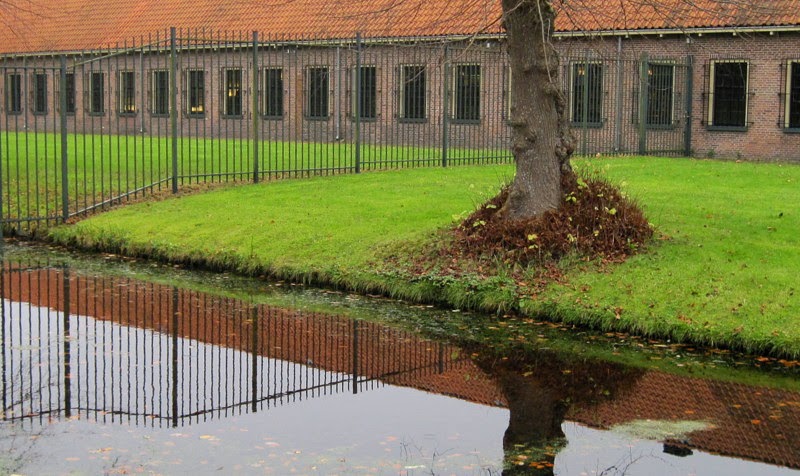This sculpture of a 'lantaarnopsteker' (lamplighter) is found across the entrance of Prison Museum Veenhuizen. Before there was electric light, street lights -mostly candles- were lit manually every evening and put out again at dawn. Another lamplighter duty was to carry a ladder and renew the candles, oil, or gas mantles.
The sculpture was created by H.S. Bosma.
Posts tonen met het label Veenhuizen. Alle posts tonen
Posts tonen met het label Veenhuizen. Alle posts tonen
23 december 2014
The lamplighter
21 december 2014
Wilhelmina-tree
Wondering about the meaning of the 'W' on the fence, we were told that this tree was planted in 1898 when Princess Wilhelmina (the grandmother of our former Queen Beatrix) became Queen of the Netherlands at the age of 18. Since then it is a tradition in our country to plant a tree at important events in the lives of the Dutch Royal Family. The most recent occasion was on 30 April 2013 with the abdication of Queen Beatrix in favour of her eldest son Prince Willem-Alexander.
So this tree is at least 116 years old! I took this photo a few weeks ago in the village of Veenhuizen.
So this tree is at least 116 years old! I took this photo a few weeks ago in the village of Veenhuizen.
16 december 2014
Bird nest?
15 december 2014
Monday mural
A mural on one of the doors inside former prison building 'De Rode Pannen', now part of Prison Museum Veenhuizen. The text says 'multiple person isolation cell'.
Taking part in Monday Mural.
Taking part in Monday Mural.
Labels:
Gevangenismuseum,
mural,
museum,
prison,
Veenhuizen
5 december 2014
De Rode Pannen prison
During our visit to the National Prison Museum in Veenhuizen we joined a guided tour in cell block building 'De Rode Pannen' ('The Red Tiles'), a convict prison built in 1939-1940. De Rode Pannen has 46 cells, and was used until 2008 for those prisoners who were extremely agressive and hard to handle. With specially trained warders and a special approach it was tried to 're-educate' these men. A stay for about 3 to 4 weeks was usually enough to change their behaviour.
Since 2012 the Prison Museum is allowed to organise tours inside this building. It is however still 'ready for use'.
Since 2012 the Prison Museum is allowed to organise tours inside this building. It is however still 'ready for use'.
Taken from the same spot as the first photo, but now looking up to the (partly) glass ceiling, and one of the cell doors on the right.
Labels:
black and white,
Gevangenismuseum,
museum,
prison,
Veenhuizen
4 december 2014
Prison Museum Veenhuizen
Last Sunday we visited the National Prison Museum in Veenhuizen. This village in the province of Drenthe was and is known for the prison complexes, of which one is still in use. The other one, named ´complex no. 2´ that you see on the photo, is now the National Prison Museum. From the 19th century the Department of Justice used it as a penal colony, so it was not an ´ordinary´ prison.
Veenhuizen used to be closed off to everyone but the inmates, and the staff and their families who lived in houses provided by the department. Since 1984 the village is freely accessible for all, which in fact doesn´t really seem that long ago..
Veenhuizen used to be closed off to everyone but the inmates, and the staff and their families who lived in houses provided by the department. Since 1984 the village is freely accessible for all, which in fact doesn´t really seem that long ago..
Labels:
fence,
Gevangenismuseum,
museum,
prison,
reflection,
Veenhuizen
Abonneren op:
Posts (Atom)








